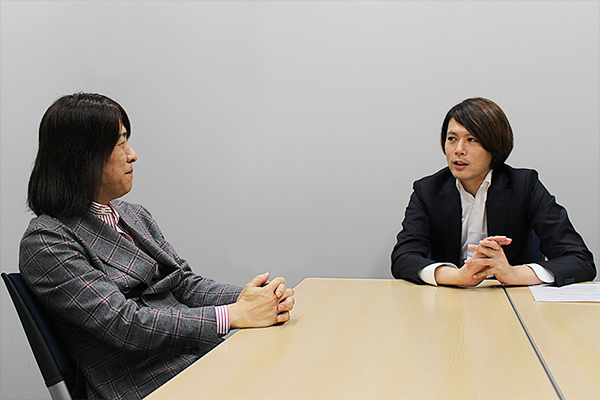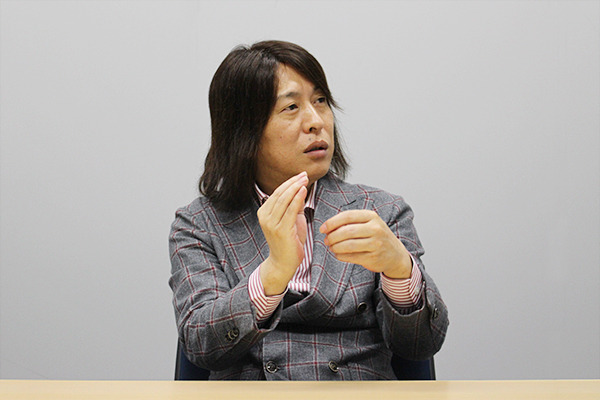This edition of Master of Innovation Management features Kazuki Arita of ONTROX Inc. We present the first part of a discussion themed around people, communities, and the surrounding environment, exploring differences in innovation and startups between Japan and the US. Together with Mr. Arita, we examine how Silicon Valley's "present" differs from Japan's "present."

Tech vs. Service Innovation and the Language Problem
Shimura: Today, we'd like to discuss innovation with Mr. Arita, who is active both domestically and internationally, starting from the differences in corporate support environments between Japan and the US. ONTROX, which Mr. Arita co-founded, has been selected for JETRO's (Japan External Trade Organization) innovation support program, the "JETRO Silicon Valley Innovation Program" (SVIP). Can you start a business from this program?
Arita: At ONTROX, we are currently focusing on our integrated analytics framework called IDG (Insight Digger Technology). Simply put, IDG is a framework that maps relationships between points and lines. It analyzes vast amounts of data and visualizes these relationships through a visualizer. For example, it can map who tweeted what on Twitter and how other users responded with actions like follows or mentions. It's also been adopted by Dentsu Inc.'s "Word-of-Mouth Designer."

IDG Concept
Being selected for SVIP has us considering expanding IDG's business into the US. It must be said that cases of Japanese companies successfully entering Silicon Valley are few and far between. While JETRO has traditionally supported ventures through subsidies, it's now beginning initiatives focused on building expertise beyond just funding.
Shimura: Logically, we understand the need to generate ideas overseas, refine them, and adapt to diversity. However, establishing this as a core business is extremely challenging. I believe the environments and approaches to business differ significantly between Japan and the US. Mr. Arita, having experienced both Japan and overseas, possesses vivid insights, which is why we invited him for this discussion.
In Japan and the US, the way innovation emerges differs—whether it starts with tech or services. What are your thoughts on this, Arita-san?
Arita: Japan has many companies developing technology, but I think there are overwhelmingly few startups that start as tech companies or sell technologies that didn't exist before. In the US, the big data boom brought the analytics market into the spotlight, leading to many tech companies emerging. However, even in the US, before the big data boom, weren't there more service-oriented startups like SNS? I hear that currently, San Francisco has more service-oriented companies, while Silicon Valley has more tech-oriented ones.
Shimura: While the U.S. is changing, is the reason services remain central in Japan because they're less costly or can launch quickly?
Arita: If you consider services to be more B2C-oriented, the appeal is that if you hit it big, you can grow significantly (laughs). Also, with services, even without specialists, you can brainstorm ideas with system engineers and programmers. On the other hand, if you focus on technology as the main focus, you need the right environment and team to nurture that technology, and without understanding the technology, you can't even come up with ideas.
Shimura: So, does that mean Japan has less knowledge of the enabling technologies?
Arita: People have been studying, but university curricula play a big role. For example, when I was looking for books on artificial intelligence (AI) to start a business in the US, Japanese bookstores had almost none. Now, entire shelves are filled with AI books, and I think the mindset has shifted to requiring an understanding of algorithms.
Shimura: Papers and technical documents are written in English, and English is used when sharing knowledge globally. Because of the language barrier, I often feel Japan has to be passive.
Arita: Last year (2013), I attended an IEEE (Institute of Electrical and Electronics Engineers) conference. Even when Japanese researchers translate their Japanese papers into English for submission, it seems they sometimes get rejected for poor English before the content is even considered. There's a real issue with English writing skills and the fact that if your writing doesn't align with how English-speaking people think, it simply won't be understood.
Shimura: Language barriers make it difficult for people outside English-speaking countries to participate in knowledge sharing and collaboration, and I feel this barrier is quite significant. Unless we overcome this, it will be hard to foster innovation that aggregates and refines knowledge.
The Importance of Teaming and the Qualities of Silicon Valley Rookies
Arita: I once heard from a lawyer that when large corporations file lawsuits, even if they assemble a large team of attorneys, the cost of managing them becomes prohibitive. They said a team of about three is optimal; if one highly capable member handles strategy, they can achieve results comparable to a large legal team. The engineering world is similar: having 100 programmers doesn't guarantee innovation. Smaller teams are better at generating innovation and operating efficiently.

Shimura: Teaming and role division are crucial. The challenge lies in how to segment into the smallest necessary group and what skills to gather in members. What are your thoughts on whether three people should naturally come together or be systematically assembled?
Arita: Team composition requires careful consideration. For instance, even if someone excels at algorithms and has strong mathematical skills, without a foundation in computer science, they won't understand infrastructure like servers and won't be able to run applications handling large amounts of data. Unless you have someone strong in the mathematical aspects and someone who knows algorithms reasonably well and is also knowledgeable in computer science on the team, you won't be able to get the product to market.
Shimura: Overseas, I get the impression that people called "rookies" or recent graduates possess a broader range of knowledge and skills compared to Japan, and can handle multiple roles within a team. I feel this is another factor making tech innovation harder to achieve in Japan.
Arita: Top universities in Silicon Valley and the Bay Area charge extremely high tuition, forcing non-wealthy students to take out loans to attend. Even after graduating from a four-year college, they're still far from being fully-fledged engineers, so they pursue Master's or Ph.D. degrees. By the time they earn their MBA, they're 30-year-old rookies. Burdened with significant debt, they naturally gravitate toward jobs offering high salaries right from their first year in the workforce.
Shimura: I think there are many people in Silicon Valley who want to strike it rich with one big hit, but I think the mindset is different. Rather than wanting to join a large company and earn a decent salary, there is a considerable gap between the US and Japan in terms of the hunger to strike it rich by utilizing one's ideas. What kind of mindset do first-year rookies in Silicon Valley have when they join a company and engage in ideation?
Arita: At one Silicon Valley company, when you join, they put a balloon on your desk. That balloon deflates in two weeks, so you have to come up with an idea before then. Coming up with an idea in two weeks means you're accepted as a member of the team.
Shimura: In Japan, when you join a company, you first receive training on manners and such, and there is no concept of spending time on ideas. The mindset and skill set when joining a company are different, and I think Silicon Valley rookies have the aptitude to come up with ideas even without group training.
Arita: Japanese companies try to imitate Silicon Valley by installing pool tables or balance balls. But in Silicon Valley, they deliberately design the office environment to resemble a campus atmosphere—something they've studied for over 30 years—to foster an environment conducive to creative thinking.
How much of an idea should be shared, and what should be protected?
Shimura: In Silicon Valley, there's no expectation of staying with a company until retirement. People with good ideas probably want to leave. The mindset around intellectual property and protecting ideas is different from Japan's. The environment is vastly different – you see headhunting where they buy the person rather than just the idea.
Overseas, when someone has intellectual property or an idea, do they talk about it? Or do they wait until it's fully developed before showing it to others? Do they only discuss it with their team or close associates? How do they bring their core ideas out into the open?

Arita: For startups, they often begin with a small team. In tech, for example, they might develop core technology in a short period, working nonstop. When founding the company or licensing it to another firm, discussing that core technology is inevitable. It's like an onion: you can't eat it without peeling it, but peel too much and it shrinks. Finding the right balance of what to reveal is the challenge.
Shimura: I think they're very adept at open-sourcing what needs to be open-sourced while protecting what needs protection. Since some companies lack funds, efforts are also made to build communities where developers mutually protect each other, rather than incurring the costs of patents.
Arita: Japanese organizations rarely take the lead in handling open source, right?
Shimura: We talk about open-sourcing things during work or using APIs, but we never actually do it. We should be tactically selling technology—like how many API calls per minute to allow and where to charge—but often we get bogged down in fundamental discussions. Compared to overseas, we just aren't as adept.
Arita: At ONTROX, engineers once suggested open-sourcing an IDG program written in Ruby (a programming language developed in Japan). But in the end, nobody used it. You can't expect to successfully lead a community if you've never even joined one yourself. You need to build a solid community. If someone closely connected to the open-source community actively participates and open-sources something, I think it would get quite a bit of use.
Shimura: We're calling for ideas online for innovation management tools, but simply submitting source code or ideas without prior online engagement, then expecting them to be reviewed and refined later, might not work well. It requires having people already part of the community, with a certain level of readiness established, so that when new source code or ideas are introduced, they can expand the scope. In Japan too, we need to cultivate people who can generate ideas and then disseminate that knowledge across broader networks.









